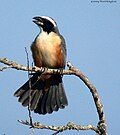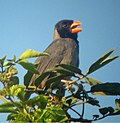| Image | Common name | Scientific name | Distribution |
|---|
 | Orinoco saltator | Saltator orenocensis | Venezuela, northeast Colombia |
 | Green-winged saltator | Saltator similis | Argentina, Bolivia, Brazil, Paraguay, and Uruguay |
 | Cinnamon-bellied (or northern grey) saltator | Saltator grandis | Mexico to Panama |
 | Olive-grey (or Caribbean grey) saltator | Saltator olivascens | Colombia, Venezuela, the Guianas, far north Brazil and Trinidad |
 | Bluish-grey (or Amazonian grey) saltator | Saltator coerulescens | Widely in tropical and subtropical South America |
 | Streaked saltator | Saltator striatipectus | Colombia, Costa Rica, Ecuador, Guadeloupe, Panama, Peru, and Venezuela. |
 | Lesser Antillean saltator | Saltator albicollis | Dominica, Martinique, Saint Kitts and Nevis, and Saint Lucia. |
 | Buff-throated saltator | Saltator maximus | southeastern Mexico to western Ecuador and northeastern Brazil. |
 | Black-winged saltator | Saltator atripennis | Colombia and Ecuador. |
 | Black-headed saltator | Saltator atriceps | central Mexico to eastern Panama. |
 | Black-cowled saltator | Saltator nigriceps | Ecuador and the northern border region of Peru. |
 | Black-throated grosbeak | Saltator fuliginosus | Atlantic Forest in far northeastern Argentina (Misiones), eastern and southeastern Brazil, and far eastern Paraguay |
 | Slate-coloured grosbeak | Saltator grossus | the Amazon in South America, but it is also found in forests of the Chocó in Ecuador and Colombia, and southern Central America from Panama to Honduras. |
 | Masked saltator | Saltator cinctus | southern Colombia, Ecuador, and Peru. |
 | Thick-billed saltator | Saltator maxillosus | Atlantic Forest in southeastern Brazil, far northeastern Argentina (only Misiones Province), and perhaps far eastern Paraguay. |
 | Golden-billed saltator | Saltator aurantiirostris | Argentina, Bolivia, Brazil, Chile, Paraguay, Peru, and Uruguay |
|
















